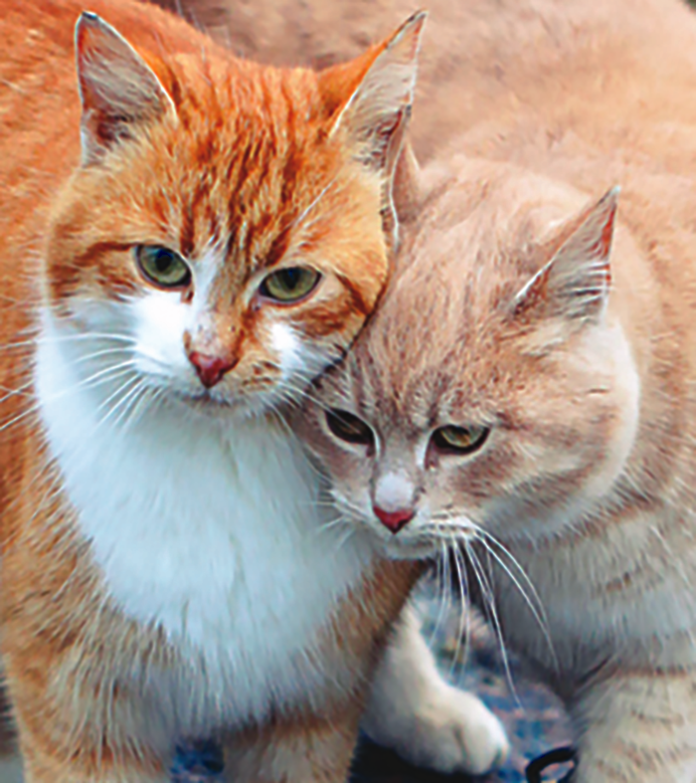Feline fecal microbiota transplants—yes, inserting feces from one cat into another—are becoming more common as a therapy for serious chronic problems, such as chronic diarrhea due to ulcerative colitis or inflammatory bowel disease. This treatment is successfully used in humans and other animals. The goal is to quickly restore the population of healthy gut microbials, overwhelming any pathogens and getting the intestinal tract back into a healthy balance.
The first step is finding a healthy donor cat without a history of gastrointestinal illness, allergies, cancer, or immune problems. Ideally, the donor cat was nursed by his mother, so he started life with a good immune boost from her milk. The cat is evaluated for a diverse, healthy microbiome (microbiota that normally reside in or on the body). Both the donor and your cat should be on matching diets so the procedure doesn’t cause a dietary allergy in your cat.
Once a donor cat has been identified, the veterinarian does a full fecal evaluation and samples are screened for pathogens, bacteria, and parasites. When a transplant is prepared, the fecal material should be fresh, appear normal, and no more than 8 hours old.
The fecal material is mixed with lactated Ringer’s solution (a mixture that replaces fluids and electrolytes in the body) to make a slurry that is then filtered to remove unnecessary particulate matter. The slurry is then inserted into the cat as a liquid enema. The cat must be sedated so she can be kept in a position to retain the transplant for at least 30 minutes. A second transplant is rarely required.
Alternatively, you can purchase capsules of prepared fecal transplant material for your cat. The fecal material is freeze-dried and packed into enteric-resistant capsules that should not dissolve until the capsule reaches the intestines. The same protocols for screening a donor cat and its feces should be followed as for the fresh transplant method.
With either method, though, your veterinarian should be involved. It is important that any medications that would influence the microbiome are avoided while the newly transplanted bacteria become established. A cat who is on a hypoallergenic or limited ingredient diet should stay on it.
Fecal transplants are still relatively new as therapies for cats with chronic intestinal problems. They show promise for the future. With more cats receiving these treatments, protocols will be fine-tuned and even more cats will be restored to good gastrointestinal health.
Probiotics
For acute diarrhea, a quality probiotic can be the treatment of choice, with medications aimed at the pathogens causing your cat problems, to restore gut flora. However, no probiotic can match a natural healthy microbiota. For chronic conditions, bigger “guns” are often needed.
Traditional Methods
With acute diarrhea, most cats recover on their own in a day or two. If a little help is needed, medications, such as metronidazole (Flagyl), are often effective. Sometimes, the fix can be as simple as a diet change. However, some cats can’t get back on track. With chronic conditions, especially, the normal gut flora can be wiped out and unable to get back in sync. For these cats, a fecal transplantation may be the boost they need.
Inflammatory Bowel Disease
No matter what type of irritable bowel disease (IBD) your cat has, he may be in pain due to the increased number of inflammatory cells in the lining of his stomach, small intestine, and colon. With IBD, a cat’s immune system reacts to the presence of pathogenic agents, including bacteria or food antigens, and the mucosal lining responsible for regulating the digestion and absorption of food is impaired. Symptoms of IBD include lethargy, weight loss, vomiting, diarrhea, and a loss of appetite. It can become a messy problem, too, with uncontrollable diarrhea.
Although cats of any age can be affected, middle-aged or older cats are more susceptible to IBD. “We don’t know what causes IBD, so when a cat is having uncontrollable diarrhea, vomiting, and acting lethargic, we start ruling out possible causes such as parasites and cancer, and we back our way into diagnosing IBD,” says Joseph Wakshlag, DVM, PhD, Section Chief of Nutrition at the New York State College of Veterinary Medicine at Cornell. “What we do know with certainty is that cats with IBD have gastrointestinal discomfort and there is constant inflammation in their intestinal walls.”
If your cat is exhibiting these symptoms, the veterinarian will most likely perform a series of diagnostic tests to rule out other conditions, such as feline leukemia virus, feline infectious peritonitis, feline immunodeficiency virus, or parasites and protozoal infections. The tests may include a complete blood cell count, a fecal examination for the presence of parasitic and bacterial agents, and abdominal X-rays and ultrasound.
However, the definitive diagnosis is achieved by the endoscopy procedure, which uses a flexible tube with optical fibers to obtain images of the cat’s stomach and intestinal tract. “Your vet may want to perform an endoscopy to look at your cat’s stomach, small intestine, and colon and take small surface biopsies of the stomach or intestine to confirm the diagnosis,” Dr. Wakshlag says.




